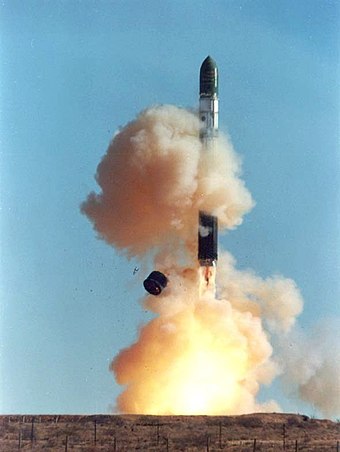SS-9 Scarp
| R-36 | |
|---|---|
 |
|
| Type | Intercontinental ballistic missile |
| Place of origin | USSR |
| Service history | |
| In service | 1974–present (only R-36M2 Voevoda variant) |
| Used by | Soviet and Russian Strategic Rocket Forces |
| Production history | |
| Manufacturer | Yuzhny Machine-Building Plant |
| Specifications | |
| Weight | 209,600 kg (462,100 lb) |
| Length | 32.2 m (106 ft) |
| Diameter | 3.05 m (10.0 ft) |
| Warhead | Depending on variant (see variants); the current one (R-36M2 Mod. 5), 10 x 550-750 kiloton MIRV warheads with a large amount of decoys and other penetration aids. Originally (Mod. 1), 1 x 18-25 megaton warhead. |
|
Detonation
mechanism |
Airburst |
|
|
|
| Engine | Two-stage liquid propellant |
|
Operational
range |
10,200–16,000 km |
| Speed | Mach 23+ |
|
Guidance
system |
Inertial, autonomous |
| Accuracy | 220–700 m CEP |
|
Launch
platform |
Silo |
The R-36 (Russian: Р-36) is a family of intercontinental ballistic missiles (ICBMs) and space launch vehicles designed by the Soviet Union during the Cold War. The original R-36 was deployed under the GRAU index 8K67 and was given the NATO reporting name SS-9 Scarp. It was able to carry three warheads and was the first Soviet MIRV (multiple independently targetable reentry vehicle) missile. The later version, the R-36M was produced under the GRAU designations 15A14 and 15A18 and was given the NATO reporting name SS-18 Satan. This missile was viewed by certain U.S. analysts as giving the Soviet Union first strike advantage over the U.S., particularly because of its rapid silo-reload ability, very heavy throw weight and extremely large number of re-entry vehicles. Some versions of the R-36M were deployed with 10 warheads and up to 40 penetration aids and the missile's high throw-weight made it theoretically capable of carrying more warheads or penetration aids. Contemporary U.S. missiles, such as the Minuteman III, carried up to three warheads at most. Russia intends to replace the R-36 with a new heavy ICBM, the RS-28 Sarmat.
The R-36 (SS-9) is a two-stage rocket powered by a liquid bipropellant, with UDMH as fuel and nitrogen tetroxide as an oxidizer. It carries one of two types of re-entry vehicles (RVs) developed especially for this missile:
...
Wikipedia
